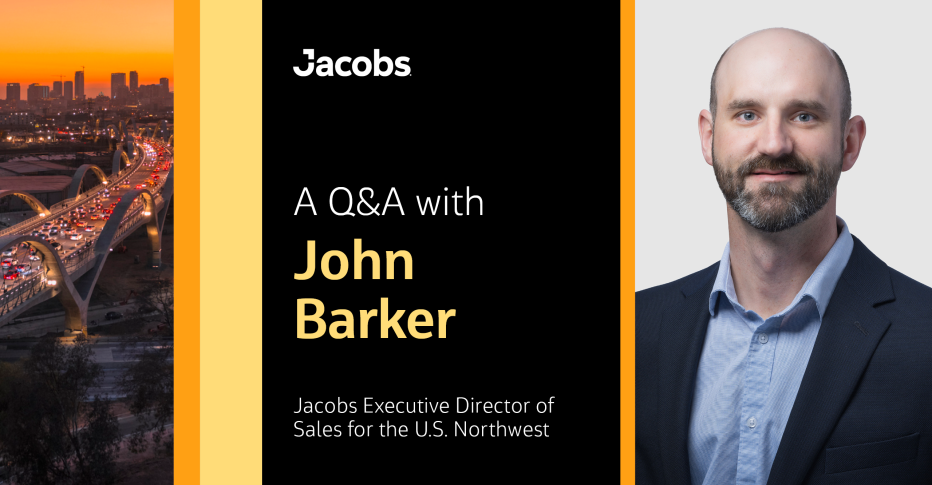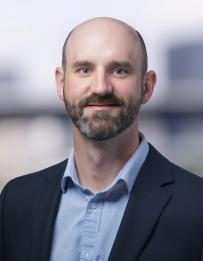
Bringing experience on infrastructure projects across the U.S. Pacific Northwest, John Barker is the new Executive Director of Sales for the Northwest.
Robust infrastructure establishes the backbone of productive, economically strong communities as assets essential to commerce, trade, public safety and quality of life.
When it comes to designing investible infrastructure that addresses the big issues we face in the world—unprecedented urbanization, catastrophic climate threats and both human and natural resources constraints, there’s no partner more capable than us – after all, Engineering News-Record named us the top firm on their Top 500 Design Firms list for the seventh consecutive year.
In this Q&A, we connect with John Barker, our new executive director of sales for the U.S. Northwest. John gives his perspective on the trends shaping critical infrastructure today and how we’re co-creating solutions with our clients for tomorrow.
Tell us a bit about your role and what a day in the life as our new Executive Director of Sales for the Northwest is like.
I’m accountable for new business and driving year-over-year growth in the Northwest region of the U.S., which includes our work in key growth markets of transportation, water, cities & places and other offerings like Operations & Facilities Management Services (OMFS) and program management. I’m blessed to work with an amazing group of client account managers (CAMs) and account strategists who build our pipeline of project opportunities and lead capture teams. Currently, I’m deep in planning with my Executive Director of Operations partner, Kristie Casarez, in setting up our framework for our next year organization to make the most out of our market-aligned structure. I’m meeting with our CAMs to review their pipelines with a focus on top opportunities and differentiating Jacobs from the competition to set ourselves up for some really exciting wins.
What are the biggest critical infrastructure challenges in the U.S. Pacific Northwest?
The twin forces of population growth and aging infrastructure are combining to create significant challenges.
Population growth is leading to increased demand for housing and results in congestion and delays for legacy transportation systems. This is also leading to environmental challenges with respect to increasing capacity on water supply and wastewater treatment. Like the rest of the U.S., much of the Northwest’s infrastructure was built decades ago. Wastewater treatment facilities are being expanded, replaced and rebranded with a new focus on water renewal. Roads are being widened and multi-modal systems are being added. Sewer pipes are being replaced. Energy systems are being modernized or enhanced for resilience with a focus on cleaner energy sources. With population growth also comes an increase in pollutants in our fresh and saltwater bodies. That degradation of water quality presents a slew of economic, cultural, and – as mentioned before – environmental challenges.
How do we help clients think differently to respond to the future?
Laws and regulations are changing in response to climate change and environmental requirements: We can help our clients plan head and design solutions that make their building systems more carbon neutral or incorporate new treatment technologies to deal with nutrient removal or contaminants of concern in water streams.
Artificial intelligence, data and digital solutions are here to stay. Some of our clients are very fixed in their approach to project delivery or problem solving. Our digital toolset, such as Intelligent O&M and StreetLight, can be relatively low-cost and high value return, bringing an increase in efficiency for our clients’ existing systems.
Six metropolitan areas within the Pacific Northwest ranked in the top percentages for population growth last year. What trends are you seeing because of this growth, both in and outside of cities?
First, as a life-long resident of Idaho and someone who has lived in the Boise area for over 15 years I can speak personally to the strain growth has put on local systems including housing, childcare, healthcare and transportation. This is a double-edged sword as it’s hard to see our communities change because of population growth and open space or farmland being turned into subdivisions.
However, there are opportunities as a solutions-oriented company to work with our clients and communities to implement growth in smart, practical ways such as embracing energy efficient buildings and implementing intelligent multi-modal transportation systems. With an increase in population comes a demand for increase in basic human needs, most essentially: water. Domestic, commercial, municipal and industrial water users all will need more water for people, for business/manufacturing and for agriculture. There’s an increased focus on water efficiency and consideration of a OneWater approach to collaborative and sustainable water management.
Is there a project you’re particularly proud of?
As a geotechnical engineer, I’ve worked on several projects I’m very proud of. This includes seismically-resilient bridges in Alaska and water conveyance systems in rural Idaho. One project that stands out is my first project management opportunity, a re-regulating reservoir design in southern Idaho that added 200 acre-feet of irrigation water storage and increased the operational efficiency of our client’s delivery system.
It’s projects like these, where you can see the impact delivered for our clients and communities, that make me proud of the work we do for critical infrastructure improvement around the world.
About the interviewee

John Barker is the newly appointed Executive Director of Sales for the U.S. Northwest at Jacobs. Prior to this role, he served as a client account manager for our clients in Idaho.
John’s experience in the region is underpinned by more than 20 years of geotechnical engineering and project management experience. He’s worked across business development and project delivery opportunities in transportation, water and environmental end markets. John says one of his favorite parts of his role is the team of people he gets to work with to win and deliver studies and designs for our infrastructure clients. Outside of work, he enjoys spending time with his wife, Sarah, and their two children, Hadley and Claire, taking in the beautiful scenery and activities that the Pacific Northwest has to offer.














































